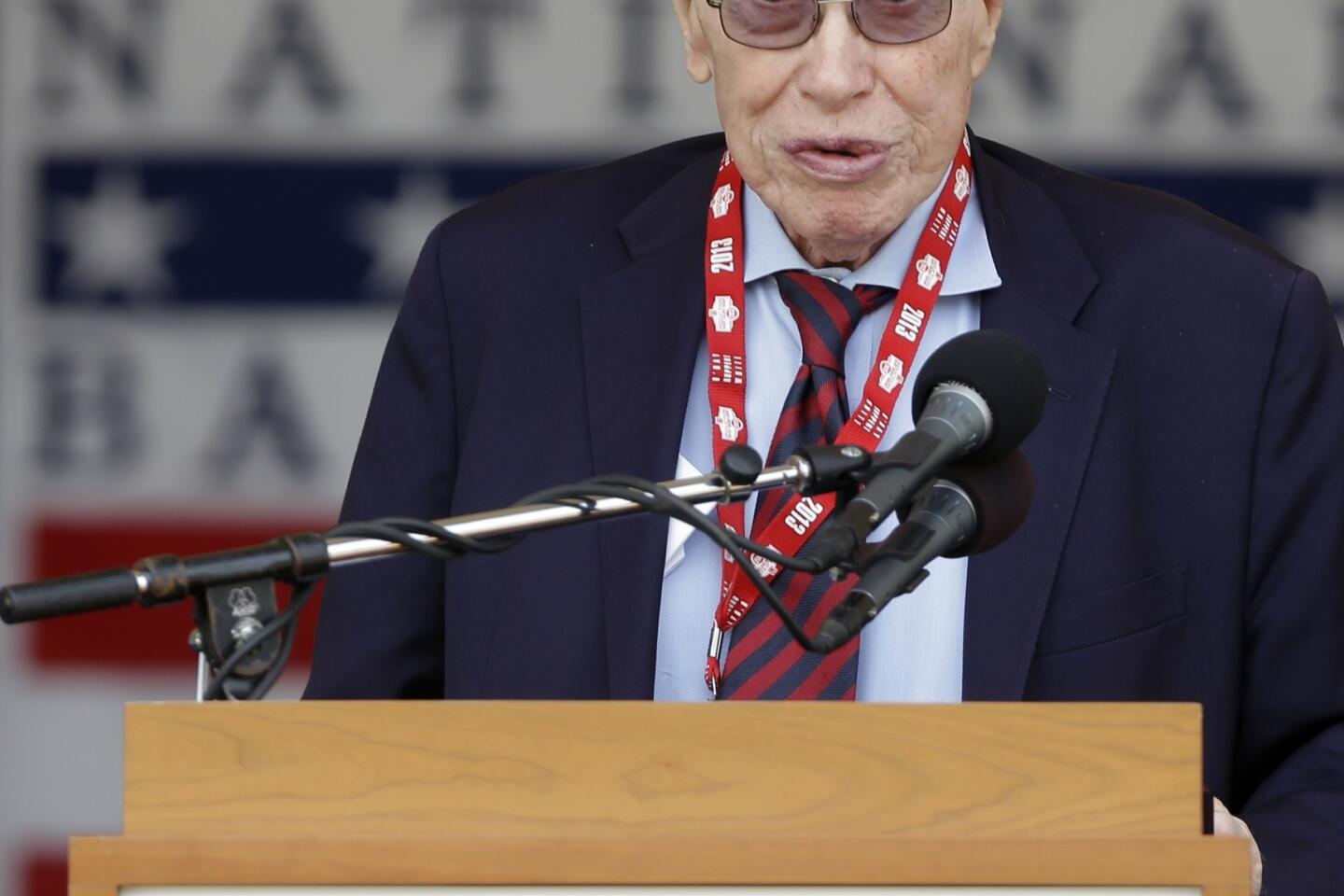Dr. Frank Jobe, a true game-changer, should be in Hall of Fame
- Share via
Frank Jobe batted third at Cooperstown last summer, in the annual awards ceremony on the Saturday before the induction ceremony.
Paul Hagen led off, a distinguished baseball writer from Philadelphia. Shirley Cheek followed, the widow of the late Tom Cheek, a beloved broadcaster for the Toronto Blue Jays.
The names of Paul Hagen and Tom Cheek would be forever displayed within the Hall of Fame.
Jobe’s award did not come with a permanent place inside the Hall of Fame — an error that ought to be rectified forthwith — but the good doctor nonetheless was delighted with his moment in the Cooperstown sun.
Jobe rose to his feet, slowly. His most famous patient, Tommy John, assisted him as he shuffled to the microphone.
And then a man who single-handedly changed the course of baseball started his speech by recalling how, back in 1965, he and partner Robert Kerlan decided to describe their work as “sports medicine.”
One of his senior orthopedic colleagues thought that was a bit much.
“ ‘Hey, young fella’ — I was a young fella then — ‘tell me the difference between a fracture in a lawyer and a fracture in an athlete,’” Jobe said. “Well, I was very embarrassed. I didn’t have a very good answer for him.”
On Friday, one day after Jobe died at 88, people in baseball were more than happy to answer for him.
“He’s touched more wins, more saves, more at-bats maybe, than anybody in baseball history,” Dodgers broadcaster, former pitcher and Jobe patient Orel Hershiser said. “He’s extended the joy of every baseball fan, because he allowed great players — and just any big leaguer — to get back on the field.”
The procedure invented by Jobe and now known as Tommy John surgery is common today, almost routine enough to diminish Jobe’s legacy among a new generation of fans. So think of it this way: Jobe deleted the words “career-ending” from the phrase “career-ending elbow injury.”
Angels pitcher C.J. Wilson had his surgery in the minor leagues. He might never have made the majors without Jobe.
“I was thinking about the billions of dollars in salary, and all the wins and saves from guys who were Tommy John survivors,” Wilson said. “It’s the single most important medical procedure in the history of baseball.”
Sandy Koufax retired at 30, after a second consecutive Cy Young award, when all of his pitching brilliance could no longer mask his searing elbow pain. The way Hershiser tells it, Jobe apologized to Koufax for not devising the landmark elbow surgery soon enough to save his career.
By 2004, when a promising high school pitcher named Nick Adenhart blew out his elbow, the Angels still signed him for $710,000, confident that Tommy John surgery would simply delay his arrival in the majors. He made his debut at 21.
To this day, shoulder exercises for major league pitchers are called “Jobe exercises.”
Said Wilson: “His name will be synonymous with baseball until the robots take over.”
Stan Conte, the Dodgers’ vice president of medical services, said the best word for Jobe might be “pioneer.” Then he came up with something better.
“In baseball,” Conte said, “he is the godfather of sports medicine.”
In his speech at Cooperstown last summer, Jobe deflected the credit for the success of Tommy John surgery to John himself.
“We did a little bit of surgery for him,” Jobe said, “but the man himself did all the hard work. His unique intelligence enabled us to develop a rehab program that has stood the test of time. Tommy returned to pitch 13 more years, without missing a single start. He won 164 more games.
“Now that is sports medicine.”
John followed Jobe to the microphone and dismissed that humility as nonsense.
“I think Jackie Robinson, Marvin Miller and Frank Jobe have done things to change the face of baseball,” John said.
Robinson is in the Hall of Fame, of course. Miller, the godfather of sports unions, is not. His shameful exclusion is a story for another day, but at least he has been considered by several committees.
Hall of Fame eligibility is extended to players, managers, umpires and executives. Miller is classified as an executive. And Jobe?
“He doesn’t have a category,” Hall of Fame spokesman Brad Horn said Friday.
Horn said the Hall of Fame is planning a display on baseball and medicine, in which Jobe will play a prominent role.
“The contributions of Dr. Jobe will live on in the museum for many years to come,” Horn said.
That is nice, but it is long past time for the Hall’s board of directors to revise the eligibility criteria for election. Since the Hall of Fame has not limited its membership to players, the only standard for eligibility ought to be historical impact.
“Broadcasters get in. Why wouldn’t you put the surgeons in?” Wilson said. “The pitcher’s elbow is like Humpty Dumpty, and he figured out how to put it back together again.”
If Jobe could figure out how to rebuild an elbow, the least the Hall of Fame could do is figure out how to put his likeness on a plaque.
Twitter: @BillShaikin
Times staff writers Kevin Baxter in Phoenix and Mike DiGiovanna in Tempe, Ariz., contributed to this report.
More to Read
Go beyond the scoreboard
Get the latest on L.A.'s teams in the daily Sports Report newsletter.
You may occasionally receive promotional content from the Los Angeles Times.












